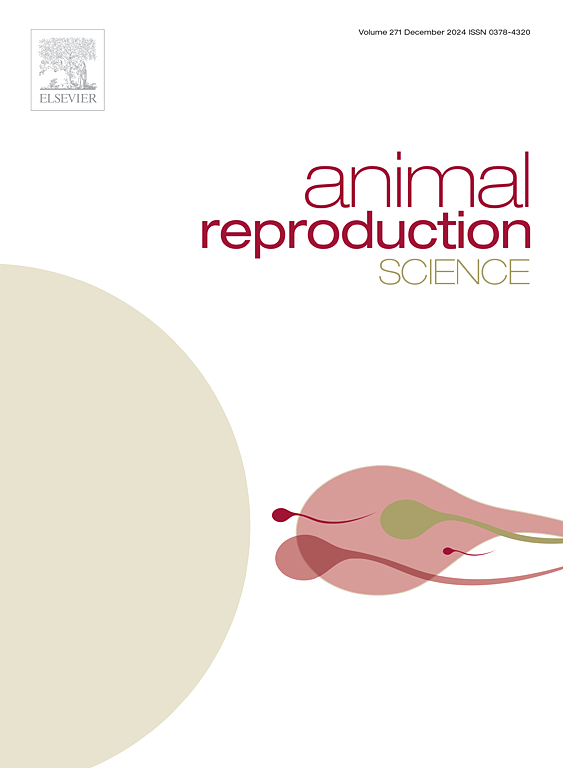Mitochondrial bioenergetics analysis on SLC-selected boar spermatozoa during liquid storage
IF 2.2
2区 农林科学
Q1 AGRICULTURE, DAIRY & ANIMAL SCIENCE
引用次数: 0
Abstract
Semen preservation at 17 °C plays a pivotal role in the porcine breeding industry, though it presents challenges; not all ejaculates retain their quality during storage. Colloidal centrifugation has been developed to improve it since this method eliminates seminal plasma and microorganisms while simultaneously allowing the selection of spermatozoa based on gradient density centrifugation. This study aimed to evaluate whether two different colloid densities (1.026 g/ml – 20 %Porcicoll® and 1.104 g/ml – 80 % Porcicoll®) improve sperm bioenergetics, assessed using Agilent seahorse, along with key semen quality parameters such as viability, mitochondrial activity, oxidative stress and motility analyzed through flow cytometry and the CASA system over time. Fifteen ejaculates were divided into three groups: Control (CTR), 20 % Porcicoll® (P20), and 80 % Porcicoll® (P80). Sperm parameters were analyzed at days 0, 3, and 7 of storage. Results revealed a metabolic shift from mitochondrial oxidative phosphorylation to glycolysis during storage, with a 15 % decrease in ATP production by day 3. P80-treated sperm showed higher ATP production on day 0 compared to P20. Sperm quality parameters such as viability and mitochondrial activity decreased after colloidal centrifugation, possibly because of early capacitation; we also hypothesize that SLC could increase sensitivity to the high glucose levels in the medium. Although Porcicoll® effectively selected metabolically active sperm, the lack of seminal plasma and limitations in media composition negatively affected long-term sperm quality. Further research is necessary to optimize media formulations and assess fertility outcomes of selected sperm for enhanced sperm preservation techniques.
slc选择的猪精子液体贮存期间线粒体生物能量学分析
17 °C的精液保存在猪养殖业中发挥着关键作用,尽管它存在挑战;并不是所有的射精在储存期间都能保持其质量。胶体离心的发展是为了改进它,因为这种方法消除了精浆和微生物,同时允许基于梯度密度离心选择精子。本研究旨在评估两种不同的胶体密度(1.026 g/ml - 20 %Porcicoll®和1.104 g/ml - 80 % Porcicoll®)是否能改善精子的生物能量学,并通过流式细胞术和CASA系统分析精液质量的关键参数,如活力、线粒体活性、氧化应激和运动。15例射精分为三组:对照组(CTR)、20% % Porcicoll®(P20)和80% % Porcicoll®(P80)。在储存的第0、3和7天分析精子参数。结果显示,在储存过程中,代谢从线粒体氧化磷酸化转变为糖酵解,到第3天,ATP的产生减少了15% %。与P20相比,p80处理的精子在第0天产生了更高的ATP。胶体离心后精子质量参数如活力和线粒体活性下降,可能是由于早期获能所致;我们还假设SLC可以增加对培养基中高葡萄糖水平的敏感性。尽管Porcicoll®有效地选择了代谢活跃的精子,但精浆的缺乏和培养基成分的限制对精子的长期质量产生了负面影响。需要进一步的研究来优化培养基配方和评估选定精子的生育结果,以增强精子保存技术。
本文章由计算机程序翻译,如有差异,请以英文原文为准。
求助全文
约1分钟内获得全文
求助全文
来源期刊

Animal Reproduction Science
农林科学-奶制品与动物科学
CiteScore
4.50
自引率
9.10%
发文量
136
审稿时长
54 days
期刊介绍:
Animal Reproduction Science publishes results from studies relating to reproduction and fertility in animals. This includes both fundamental research and applied studies, including management practices that increase our understanding of the biology and manipulation of reproduction. Manuscripts should go into depth in the mechanisms involved in the research reported, rather than a give a mere description of findings. The focus is on animals that are useful to humans including food- and fibre-producing; companion/recreational; captive; and endangered species including zoo animals, but excluding laboratory animals unless the results of the study provide new information that impacts the basic understanding of the biology or manipulation of reproduction.
The journal''s scope includes the study of reproductive physiology and endocrinology, reproductive cycles, natural and artificial control of reproduction, preservation and use of gametes and embryos, pregnancy and parturition, infertility and sterility, diagnostic and therapeutic techniques.
The Editorial Board of Animal Reproduction Science has decided not to publish papers in which there is an exclusive examination of the in vitro development of oocytes and embryos; however, there will be consideration of papers that include in vitro studies where the source of the oocytes and/or development of the embryos beyond the blastocyst stage is part of the experimental design.
 求助内容:
求助内容: 应助结果提醒方式:
应助结果提醒方式:


